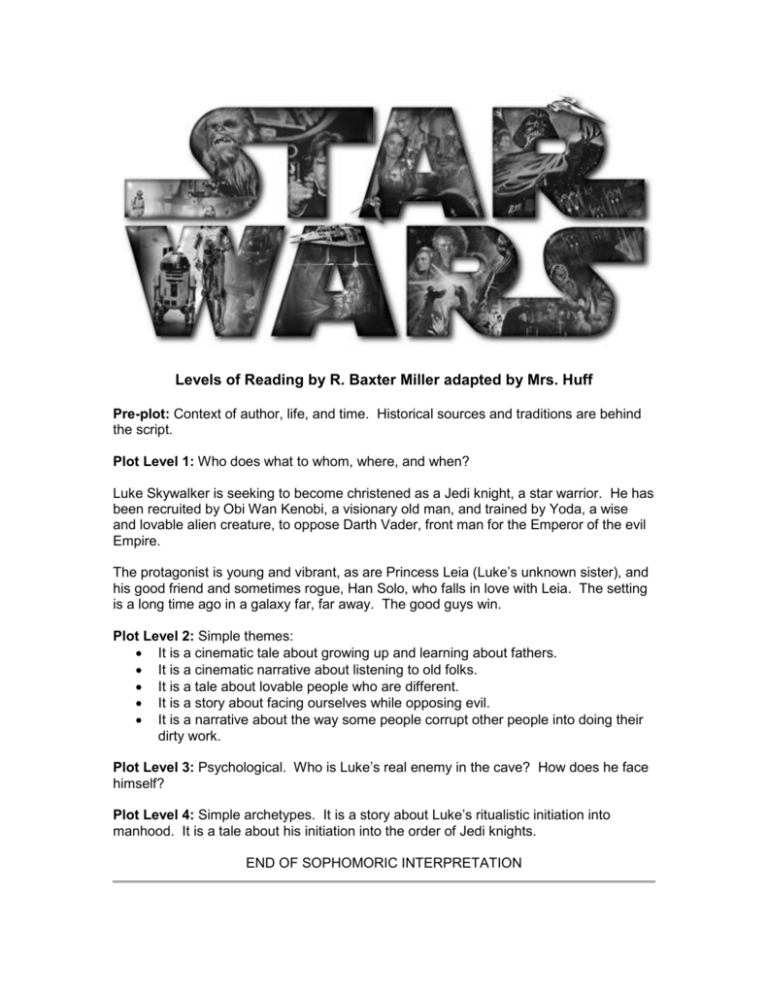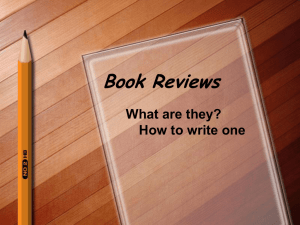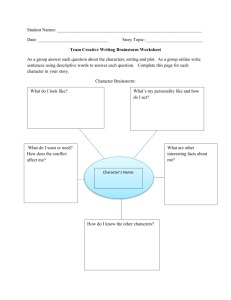Star Wars Levels of Reading (MS Word document)
advertisement

Levels of Reading by R. Baxter Miller adapted by Mrs. Huff Pre-plot: Context of author, life, and time. Historical sources and traditions are behind the script. Plot Level 1: Who does what to whom, where, and when? Luke Skywalker is seeking to become christened as a Jedi knight, a star warrior. He has been recruited by Obi Wan Kenobi, a visionary old man, and trained by Yoda, a wise and lovable alien creature, to oppose Darth Vader, front man for the Emperor of the evil Empire. The protagonist is young and vibrant, as are Princess Leia (Luke’s unknown sister), and his good friend and sometimes rogue, Han Solo, who falls in love with Leia. The setting is a long time ago in a galaxy far, far away. The good guys win. Plot Level 2: Simple themes: It is a cinematic tale about growing up and learning about fathers. It is a cinematic narrative about listening to old folks. It is a tale about lovable people who are different. It is a story about facing ourselves while opposing evil. It is a narrative about the way some people corrupt other people into doing their dirty work. Plot Level 3: Psychological. Who is Luke’s real enemy in the cave? How does he face himself? Plot Level 4: Simple archetypes. It is a story about Luke’s ritualistic initiation into manhood. It is a tale about his initiation into the order of Jedi knights. END OF SOPHOMORIC INTERPRETATION Plot Level 5: More complex myth and archetype. Righteous human, perhaps even biblically based, Luke Skywalker (who walks the skies as Jesus walked on water?) is initiated into fulfilling prophecy and cosmic destiny by defeating the Death (Darth Vader) posed by mechanistic society and redeeming the spirit of humanity (Jedi knights). Plot Level 6: Even more complex myth and archetype. Luke’s only partial bond to Reagan-era America (the four-hundred-year-old inheritor of the conservatism and militarism of the two-thousand-year Roman Empire) resembles that of the ethical radical (Socrates, Jesus, Galileo, Gandhi, JFK, MLK) who refuses to accept a wholly regimented and mechanized society that denies the imaginatively spiritual power of the Force: Life. Plot Level 7: The cinematic language of light. The blue light sabers of the ethical principle oppose the red light sabers of the unethical principle in a cinematic language wherein the cosmic battle (Jesus, King Arthur) suggests a narrative language that addresses itself at once to medieval times suggested by chivalric weapons and to the future of lasers (light swords) as imagined in science fiction. Plot Level 8: Deconstruction (an admittedly cynical reading). What do the traditional languages of Christianity and Western individualism in the film hide about their own corruption and barbarism? Through a tragic theory of literature and the universe, we find no redemption or justification for either heroism or our place in the world. A great JudeoChristian comedy informs Star Wars. The deepest text of the movie is, in other words, the imaginative development of the way that the ethical self grows into its own imaginative power, defeats the mechanized society that would enslave it (yet manages to absorb the advantages while purging itself of the corruption), and restores the aristocratic ideal of Princess Leia to be married to Han Solo (American and Western individualism one and maybe still gone amok) against the Marxist infestation of the dark hordes (Native Americans, blacks, working women, Arabs: the lovable Ewoks back in their places). The achievement is brilliantly masterful and entertaining at all levels. But are the Christians and aristocrats always good? Plot Level 9: Integration and synthesis of several levels above. The way that plot levels 7 and 8 both take root in plot level 1 but achieve together a profound irony in cinematic language about the values of American civilization. So where’s the text? Do we mean the text of only forms (stories, plays, and poems) most narrowly and naively defined? (English majors!) Do we mean the text of human, Western, and American history? (humanists) Do we mean the text of class allegiance, including who’s in power, reading and determining the terms of publication (Marxists, feminists, Black Aestheticians) Do we mean the text of women or men/gender? (gender critics) Do we mean the text of race, and can it ever be erased from the text of form? (deconstructive skeptics) Do we mean the text of human consciousness? (psychoanalysts and mythmakers like Campbell) Do we mean the inclusive text of human literature? (enlightened readers) What did Campbell think of Star Wars? We examine this question in his interview with Bill Moyers, The Power of Myth.








